Know Your Pet’s Triggers
Before you hit the road or board a plane, get clear on what actually unsettles your pet. For many, it’s the motion of a car. Others panic at unfamiliar sounds or get anxious when separated from their people. Some pets react to all three. Watch how they respond to typical triggers like engine noise, being confined, or seeing luggage come out. You’ll start to spot patterns.
Start with short, low pressure practice trips maybe just around the block. Make a note of your pet’s reactions. Do they pant, hide, whine, or freeze up? Journaling a few test runs can be the key to understanding what needs work before travel day.
Also, not all pets are wired the same. Some breeds are more sensitive to motion, temperature swings, or even scents. Talk to your vet. They know your pet’s history and breed traits. They can flag issues early and point you toward strategies or treatments that work best for your situation.
Prep Starts Days Before Departure
Travel day doesn’t start on travel day. Give your pet a head start by easing them into the routine changes they’ll experience. First up: adjust mealtime to match the planned travel schedule. If you’re hitting the road early, start feeding them earlier in the days leading up so their system’s in sync. This helps with digestion and reduces upset stomachs while in motion.
Next, make carriers or restraints familiar not foreign. Leave the carrier out at home with a blanket or treat inside. Let your pet explore it on their terms. If you’re using a seatbelt harness, clip them in for short durations while parked, then move to slow neighborhood drives.
Finally, train for calm with short bursts. A quick five minute drive, a few minutes in the crate with the door shut it adds up. These short sessions help desensitize them to the experience, so by travel day, it’s not a shock. You’re not looking for perfection, just a steady dial down of the drama.
Travel Day Gear Checklist
When it’s finally time to hit the road, having the right gear makes all the difference not just for efficiency, but for your pet’s peace of mind.
Start with a familiar smelling blanket or favorite toy. That one item they always drag around the house? It belongs in the travel bag. It helps ground them when everything else feels unfamiliar.
A leak proof water bowl is a must, especially for longer trips bonus points if it’s collapsible. Pair it with a few light snacks (not a full meal save that for later) to keep energy and comfort levels steady.
Make sure your pet is wearing a secure, well fitted leash and ID tags. Microchips are great, but visible tags with your contact info are still the fastest way to get reunited if anything goes sideways.
Pack pet friendly wipes, too. Because accidents and muddy paws happen where and when you least expect them.
And if you’re flying, make sure the crate is airline approved, well ventilated, and just big enough for your pet to turn around and lie down. Don’t skip the labeling a clear tag with your name, your phone, and ‘LIVE ANIMAL’ printed on all sides? Non negotiable.
The checklist isn’t long, but each item earns its spot.
En Route Calm Techniques

Once you’re on the road (or in the air), keeping your pet steady is more about tone than tools. Speak softly. Move slowly. Sharp sounds and sudden gestures can spike anxiety fast, especially in confined spaces.
Bring the mood down with low, steady background noise. A soft playlist or white noise machine can drown out jarring sounds think honking, engine rumble, or chatty seatmates.
If your pet’s in a crate or carrier, cover it loosely with a light, breathable cloth. This dims the overstimulation and helps them feel enclosed without feeling trapped.
And skip the wide open windows. A crack for air is one thing full gusts bring on noise, smells, and motion chaos that can undo any calm you’ve built up.
For more tips from the field, check out this essential guide.
Natural Remedies & Vet Help
Not every pet handles travel the same way. Some need a little extra help staying settled, and that’s where natural remedies can make a big difference. Calming sprays and pheromone diffusers are simple, low intervention tools that mimic the comforting smells of home or replicates the soothing scent mothers produce for their litters. You can spray them on bedding or use a plug in diffuser for the crate.
Then there are vet approved chews and calming supplements usually made with ingredients like L theanine, chamomile, or CBD (if legal in your area). These aren’t cure alls, but they can take the edge off without knocking your pet out. Just make sure to test them well in advance of your trip to monitor any effects.
For pets with extreme anxiety think shaking, whining, or refusing to eat or move it’s worth speaking with your vet weeks ahead of time. There are prescription options available, but timing and dosage are important. Do not wait until the night before to make that call.
Quick DON’Ts to Remember
Some mistakes just aren’t worth the risk when you’re traveling with a pet. First: don’t load them up with food right before you hit the road. A small stomach is better for motion, and fewer messes. Give them time to digest think hours, not minutes.
Second: don’t sedate your pet unless a vet has given you the green light. What seems calming to you could be dangerous in transit, especially at altitude or in a moving vehicle. If they truly need help unwinding, your vet can suggest options that don’t compromise their safety.
And never, ever leave your pet alone in a vehicle. Even on a mild day, temperatures rise fast and can become lethal in minutes. Plus, anxiety spikes when they’re isolated in a strange place. If your pet can’t come with you when you step out, stay with them. Full stop.
More Ways to Travel Without Stress
The less your pet’s routine changes, the better. Feed them close to the usual time. Walks, naps, even bathroom breaks if you can mirror their home schedule, you’ll avoid unnecessary stress.
Long road trip? Plan breaks every couple of hours. Let them stretch, sniff around, take a drink, and reset. These small pauses go a long way in keeping them calm and preventing pent up energy or anxiety.
And remember, they take their cues from you. If you’re rushed, flustered, or snippy, they’ll feel it. Speak gently, move purposefully, and keep your energy steady. You’re the anchor in a world that’s suddenly in motion for them.
The goal? A safe, smooth trip that your pet can actually enjoy or at least, not dread.


 Pet Travel & Safety Consultant
Jimmy Dixoneser is the go-to expert on pet travel and safety at Pet Paw Shack. He provides valuable guidance on how to ensure pets are safe, comfortable, and stress-free when traveling. From creating checklists for pet-friendly vacations to advising on the best travel gear, Jimmy’s expertise helps pet owners confidently navigate adventures with their pets, whether on the road or in the air.
Pet Travel & Safety Consultant
Jimmy Dixoneser is the go-to expert on pet travel and safety at Pet Paw Shack. He provides valuable guidance on how to ensure pets are safe, comfortable, and stress-free when traveling. From creating checklists for pet-friendly vacations to advising on the best travel gear, Jimmy’s expertise helps pet owners confidently navigate adventures with their pets, whether on the road or in the air.
